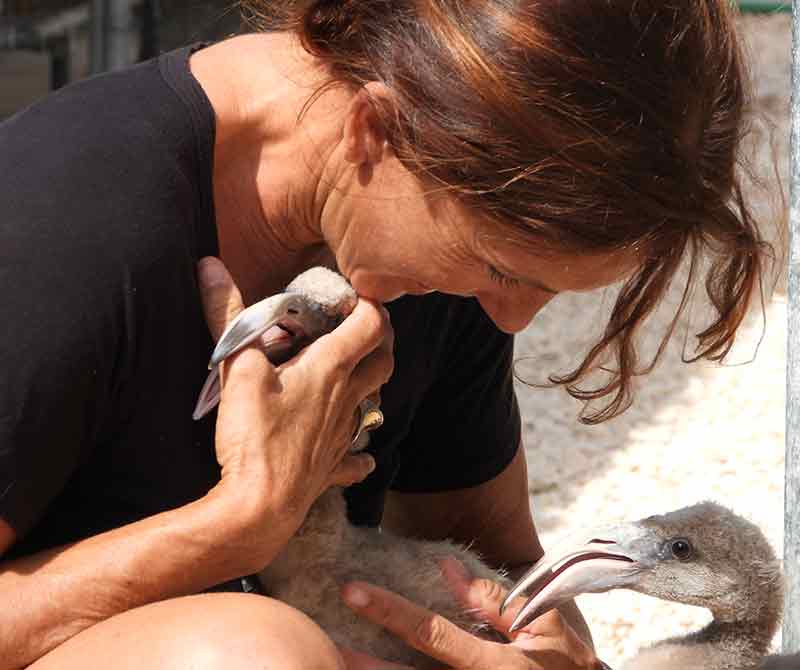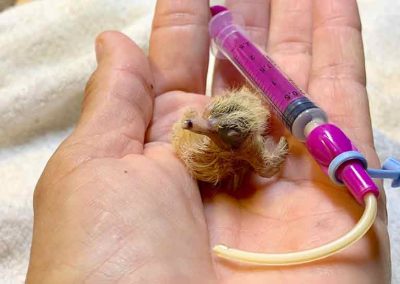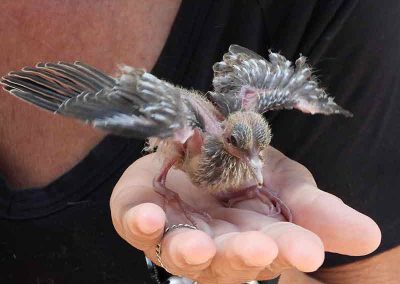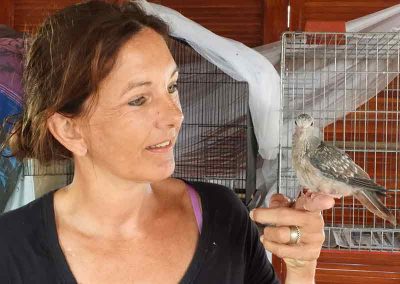Bonaire’s flamingo chicks are in need of help, once again.
Springtime, 2018, found many Bonaire flamingo chicks requiring care.
It was this time last year, when Elly Albers, the owner/operator of the Mangrove Info Center, located at Lac Bay, heeded the call for help when many of Bonaire’s young flamingo chicks were suffering from weakness and malnutrition. At her own expense, Elly imported the proper flamingo food, took the chicks in, frenetically built cages in which to house them, and saved the lives of over 350 young flamingos. It was estimated that there were about 1000 chicks born in the spring last year, so fully one-third needed assistance. This was not the first time that Elly sprang into action to assist, as in 2017 she learned–via the school of hard knocks–exactly how to care for injured wild birds, when several seabirds were covered in oil, after a spill in Trinidad made its way down current to Bonaire’s east coast.
In order to help defray costs, in June 2018, Elly created the non-profit Bonaire Wild Bird Rehab, which allowed her to accept donations. Since that time, she has had sick or injured wild birds in her care, around the clock, 365 days a year.
This year, Bonaire’s flamingo chicks also require assistance.
One month ago, Bonaire Wild Bird Rehab had only nine flamingo chicks in its care. Elly was hopeful that the issues seen in 2018 would not occur again. Unfortunately, with the arrival of the season’s normally strong winds, chicks have once again been blown from their nesting areas and can be found nearby the roadside in the southern half of the island. In the last three weeks, over 130 flamingo chicks have been rescued and brought to the rehab. If estimates of chicks are correct–that there are approximately 1000 chicks–then 15% have required assistance in only the last three weeks. And more arrive each day, sometimes as many as 15 in one day.
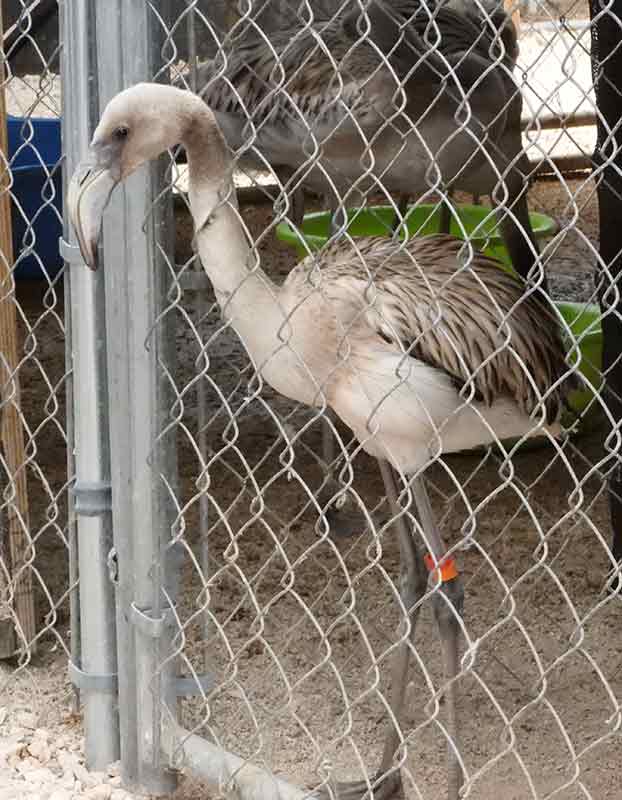
Flamingo chicks are arriving with signs of exhaustion and they are underweight.
Nearly all of this year’s flamingo chicks arrive at the rehab center with two problems: They are all underweight, and there is a noticeable lack of energy indicated by hanging wings. Some which are in rather worse shape also have a low body temperature.
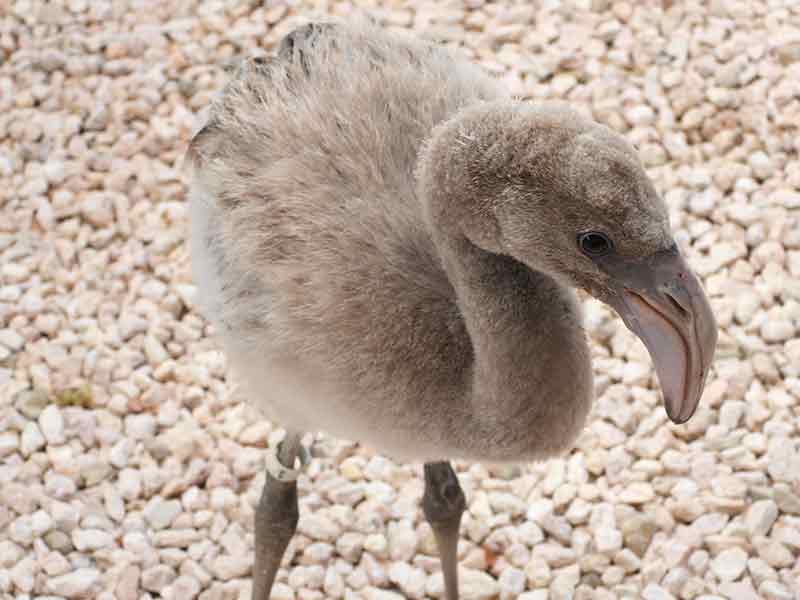
What is the protocol when a flamingo chick is brought to the rehab center?
The first order of business when a chick arrives is to take its temperature. Flamingos normally have a body temperature of 40º Celsius (104º Fahrenheit). If the body temperature is below 36.50º Celsius (97.7º Fahrenheit), nothing can be done until the body temperature comes up. The chick is kept isolated, quiet, without distractions, and out of the wind. Some flamingos have arrived with body temperatures as low as 30º Celsius (86º Fahrenheit).
If a chick is fed a liquid diet before its body temperature is 36.50º Celsius (97.7º Fahrenheit), the body will shunt all energy to the stomach to digest the food. Bodily systems then shut down as there simply isn’t enough energy to handle digestion and normal body functions. The chick will die.
Once the chick achieves a body temperature of at least 36.50º Celsius (97.7º Fahrenheit), then feeding can commence. Feeding of the young chicks is done by hand, chick by chick, with a feeding tube. This occurs every two hours, around the clock.
Blood is also drawn, and the blood can be immediately checked for red blood cell counts, which, if low, may indicate anemia. If the bird is exhibiting signs of exhaustion (indicated by hanging wings), the wings can be taped up to allow the bird to expend its energy on getting stabilized.
Bonaire’s flamingo chicks, 2018 versus 2019
Last year, the situation was more manageable, as Bonaire’s flamingo chicks were arriving at the rehab center in small batches at a time. The chicks could be stabilized, fed, and nurtured, and then could be released, thus making room for the next batch.
However, what is being seen in 2019 is that the situation is more drastic, in that hundreds of birds are requiring assistance, all relatively at the same time. Additionally, the chicks arriving at the rehab center are younger and will require longer care before they can be released. They must be able to fly before they can be released back into their natural habitat.
And so, Bonaire Wild Bird Rehab is housing over 100 flamingos right now, and it looks like that number will still increase. The majority of the rehab center’s residents will need to stay at least a month or two more before they gain their flight feathers and are able to fly.
What is causing this problem each springtime?
This has been a returning phenomenon now in both 2018 and 2019. Although there are many opinions and hypotheses as to why this problem has arisen, Elly tells us that no one really knows why the flamingo chicks do not appear to have sufficient food in the nesting area. She says:
“There must be research done in order to determine why the food supply is not sufficient. I fear that if the young flamingos are not strong enough to fly to Venezuela to feed, they will have a difficult time.”
Elly went on to say that many prior residents of the rehab center (from last year, or even four or five months ago), fly in each morning to have some breakfast. They are adults, and not requiring medical attention, but obviously, they are not finding enough food in their normal habitat.
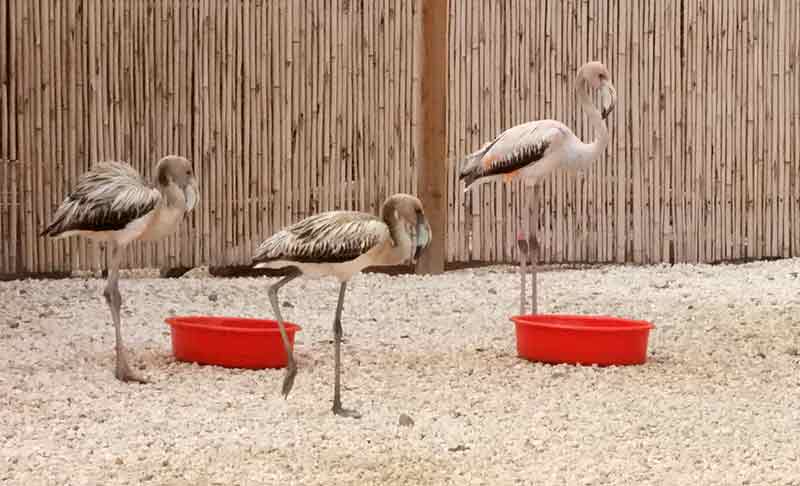
How can I tell if a flamingo is in trouble and needs a rescue?
What do I do if I find a flamingo chick in need?
Please call the Animal Rescue Foundation (Fundashon Kunuku Kakelvers) immediately. Their phone is +(599) 780-8020. Please stay with the flamingo until help arrives, as otherwise, the rescue workers may not be able to find it again.
If the flamingo appears to be in dire need of attention, approach it quietly, wrap a towel around it, covering its head, and bring it to Bonaire Wild Bird Rehab on Kaminda Lac (next to the Mangrove Info Center). Be sure to turn off air-conditioning in your vehicle while transporting a flamingo chick.
Bonaire Wild Bird Rehab assists other wild birds in need, as well.
If you see another bird in need, try to quietly catch the bird, and bring it to the rehab center. Recently a small, just-hatched dove was brought in. It was so tiny, it could hardly be fed with a feeding tube. Four weeks later, it is a healthy, happy dove, on its way to total independence.
Meet “Condor” the dove who thinks it is a condor!
It takes an island to save a flamingo.
Although Elly Albers is at the forefront of this tremendous effort to help Bonaire’s wild birds, she is not the only one who deserves thanks and praise. There is a remarkable corps of volunteers who assist at the rehab center, as well as the wonderfully giving folks at the Animal Rescue Foundation. And thanks should also go to the visitors and residents on Bonaire who take the time from their vacations and busy lives to assist a bird in need. It is truly an amazing team and network that is helping out Bonaire’s flamingos.
About Bonaire Wild Bird Rehab.
Bonaire Wild Bird Rehab was established on June 1st, 2018. In the past nine months, the center has literally saved the lives of hundreds of birds, including the island’s resident birds, as well as those needing assistance during, or after, long migrations, some of which can be up to 4,000 kilometers (2,500 miles).
The rehab center is not open to the public.
Although many visitors want to visit the rehab center and learn more about the birds which the center is assisting, unfortunately, that is not possible. Consider the rehab center as the island’s avian hospital. To liken the image to a human’s perspective, think about needing restful care in a hospital while a herd of elephants is tromping through the corridors. The rehab center’s residents require quiet and must be free of distraction and noise, in order to better recover.
But you can help Bonaire’s flamingos.
Those who would like to assist with this effort can certainly help by donating funds to defray the costs at the rehab center. Every single dollar of every single donation goes directly for food, medical supplies, and shelter for the birds. Thank you in advance for helping the island out with this effort for our iconic pink flamingo!
Crowdfunding:
The easiest way to make a donation to Bonaire Wild Bird Rehab is through the current GoFundMe campaign. No amount is too small, and every penny will be used to help Bonaire’s birds. Simply click the button below.
Bank Transfer:
For those on Bonaire, take advantage of online banking and deposit funds directly into the foundation’s checking account. Here are the details:
Bonaire Wild Bird Rehab
Kaminda Lac 140
Bonaire
RBC Bank RBTTBQBN
Account 8400000900026943
(Source: Bonaire Insider Reporter)

